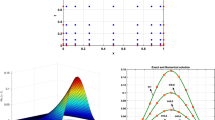Abstract
We propose an implementation of symplectic implicit Runge-Kutta schemes for highly accurate numerical integration of non-stiff Hamiltonian systems based on fixed point iteration. Provided that the computations are done in a given floating point arithmetic, the precision of the results is limited by round-off error propagation. We claim that our implementation with fixed point iteration is near-optimal with respect to round-off error propagation under the assumption that the function that evaluates the right-hand side of the differential equations is implemented with machine numbers (of the prescribed floating point arithmetic) as input and output. In addition, we present a simple procedure to estimate the round-off error propagation by means of a slightly less precise second numerical integration. Some numerical experiments are reported to illustrate the round-off error propagation properties of the proposed implementation.
Similar content being viewed by others
References
Brouwer, D.: On the accumulation of errors in numerical integration. Astron. J. 46, 149–153 (1937). doi:10.1086/105423
Dumitru, N.D.: Fast detection of chaotic or regular behavior of double pendulum system: application of the fast norm vector indicator method SEECCM III (South East European Conferentce on Computational Mechanics). doi:10.13140/2.1.5033.2969 (2013)
Grazier, K., Newman, W., Hyman, J.M., Sharp, P.W., Goldstein, D.J.: Achieving Brouwer’s law with high-order stormer multistep methods. ANZIAM J. 46, 786–804 (2005). doi:10.21914/anziamj.v46i0.990
Hairer, E., Lubich, C., Wanner, G.: Geometric numerical integration: structure-preserving algorithms for ordinary differential equations, vol. 31 Springer Science & Business Media. doi:10.1007/3-540-30666-8 (2006)
Hairer, E., McLachlan, R.I., Razakarivony, A.: Achieving Brouwer’s law with implicit runge–kutta methods. BIT Numer. Math. 48(2), 231–243 (2008). doi:10.1007/s10543-008-0170-3
Higham, N.J.: Accuracy and stability of numerical algorithms. Siam. doi:10.1137/1.9780898718027 (2002)
Kahan, W.: Further remarks on reducing truncation errors. Commun. ACM 8(1), 40 (1965)
McLachlan, R.I., Atela, P.: The accuracy of symplectic integrators. Nonlinearity 5(2), 541 (1992). http://iopscience.iop.org/article/10.1088/0951-7715/5/2/011/meta
Muller, J., Brisebarre, N., De Dinechin, F., Jeannerod, C., Lefevre, V., Melquiond, G., Revol, N., Stehlé, D., Torres, S.: Handbook of floating-point arithmetic. Springer Science & Business Media. doi:10.1007/978-0-8176-4705-6 (2009)
Sanz Serna, J., Calvo, M.: Numerical Hamiltonian problems. Chapman and Hall (1994)
Author information
Authors and Affiliations
Corresponding author
Rights and permissions
About this article
Cite this article
Antoñana, M., Makazaga, J. & Murua, A. Reducing and monitoring round-off error propagation for symplectic implicit Runge-Kutta schemes. Numer Algor 76, 861–880 (2017). https://doi.org/10.1007/s11075-017-0287-z
Received:
Accepted:
Published:
Issue Date:
DOI: https://doi.org/10.1007/s11075-017-0287-z




